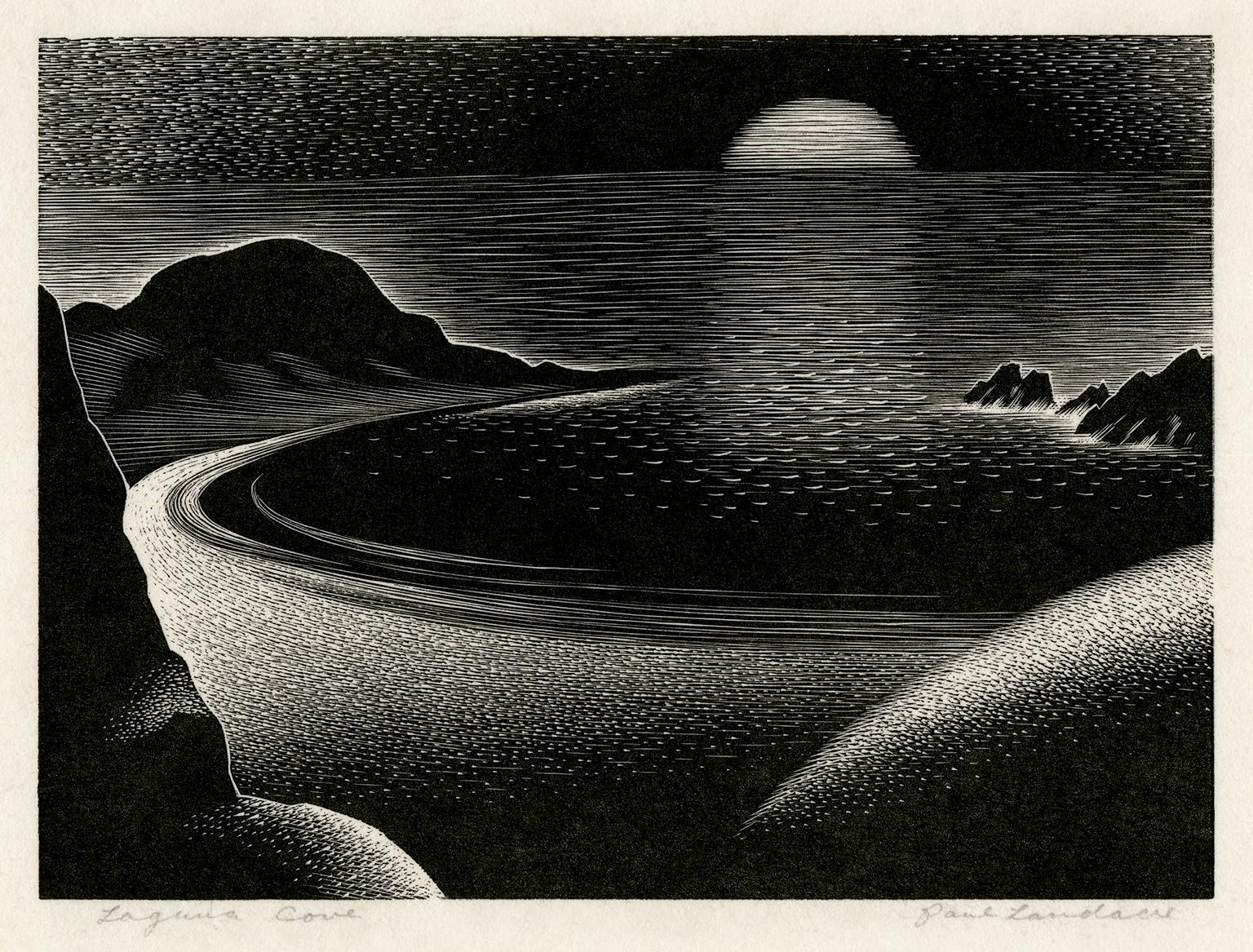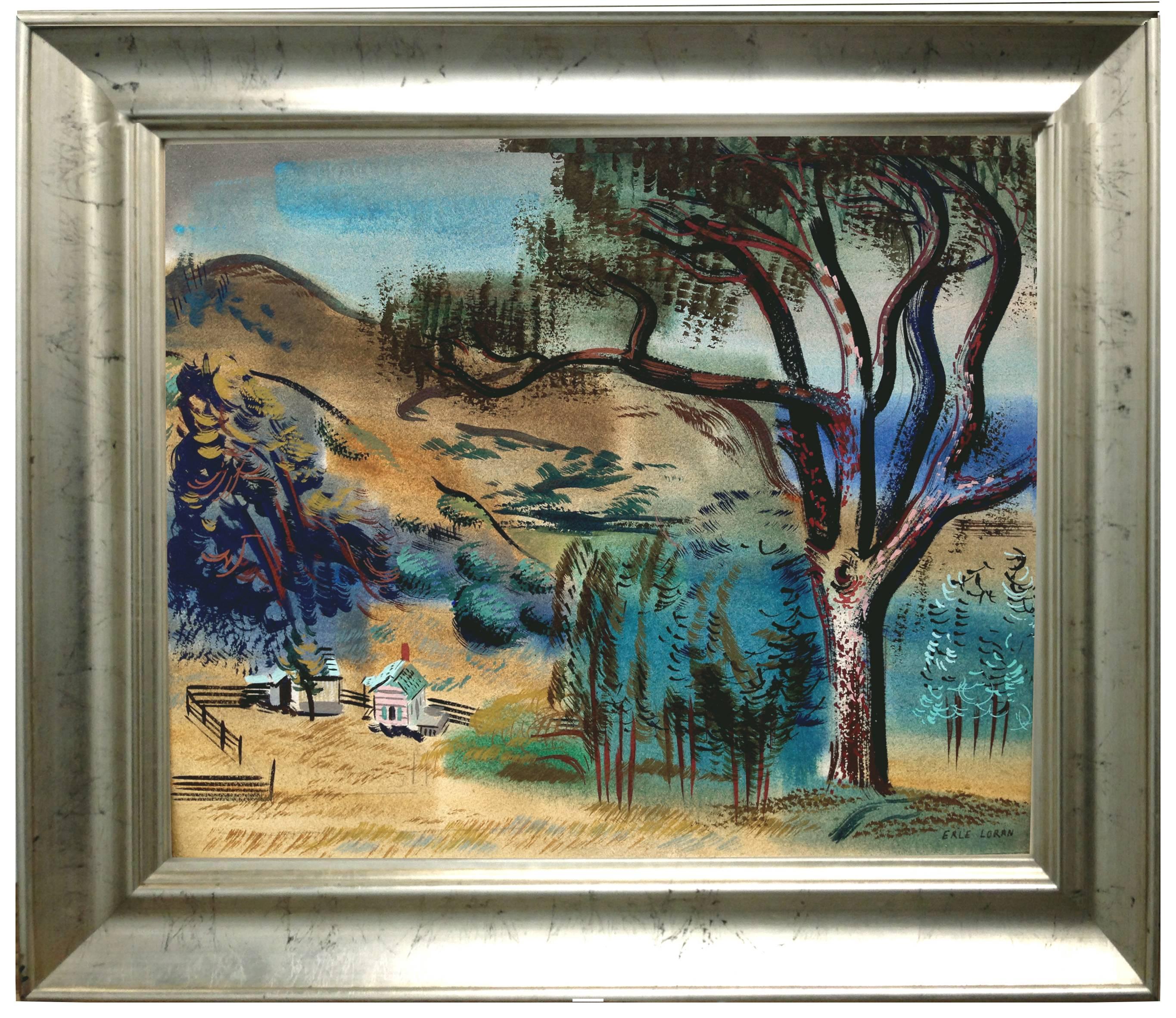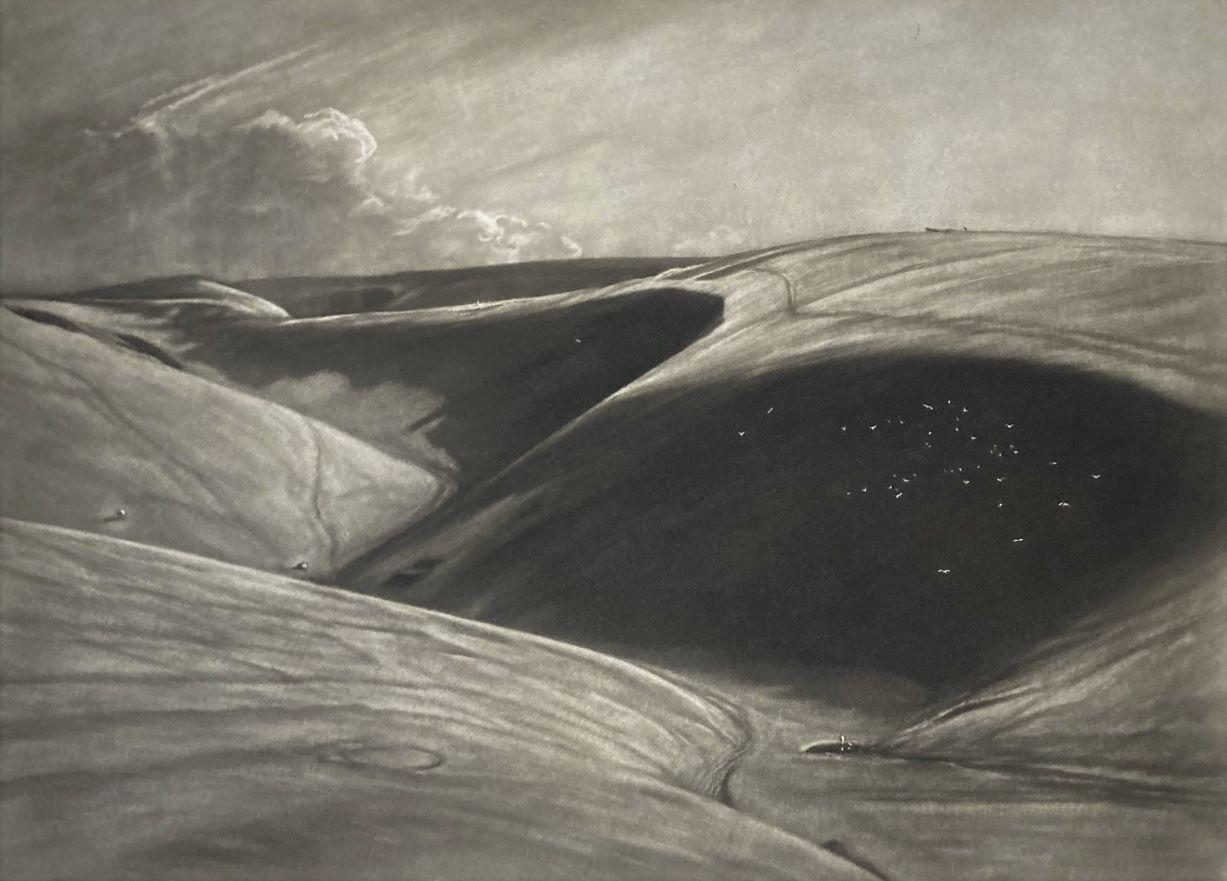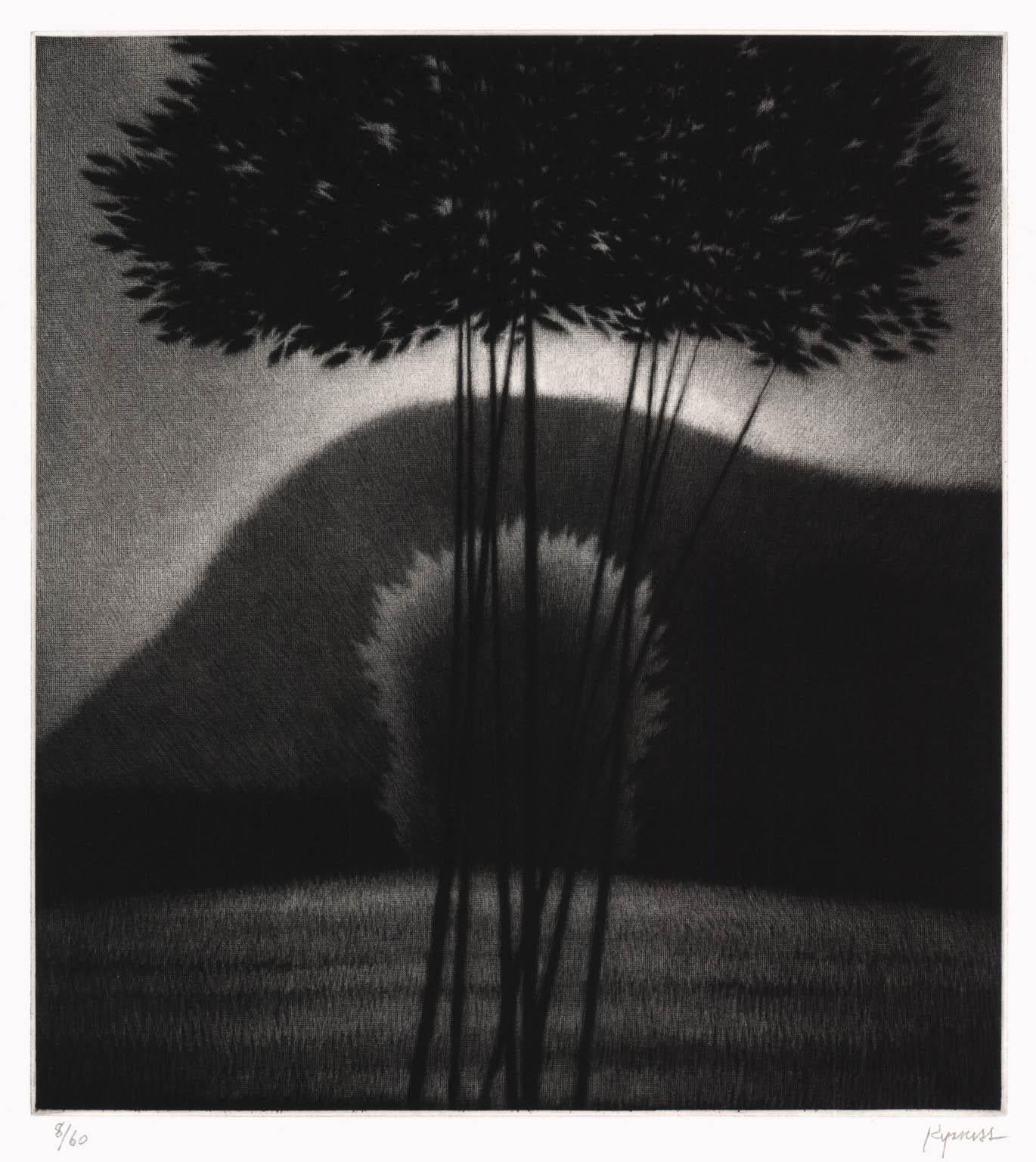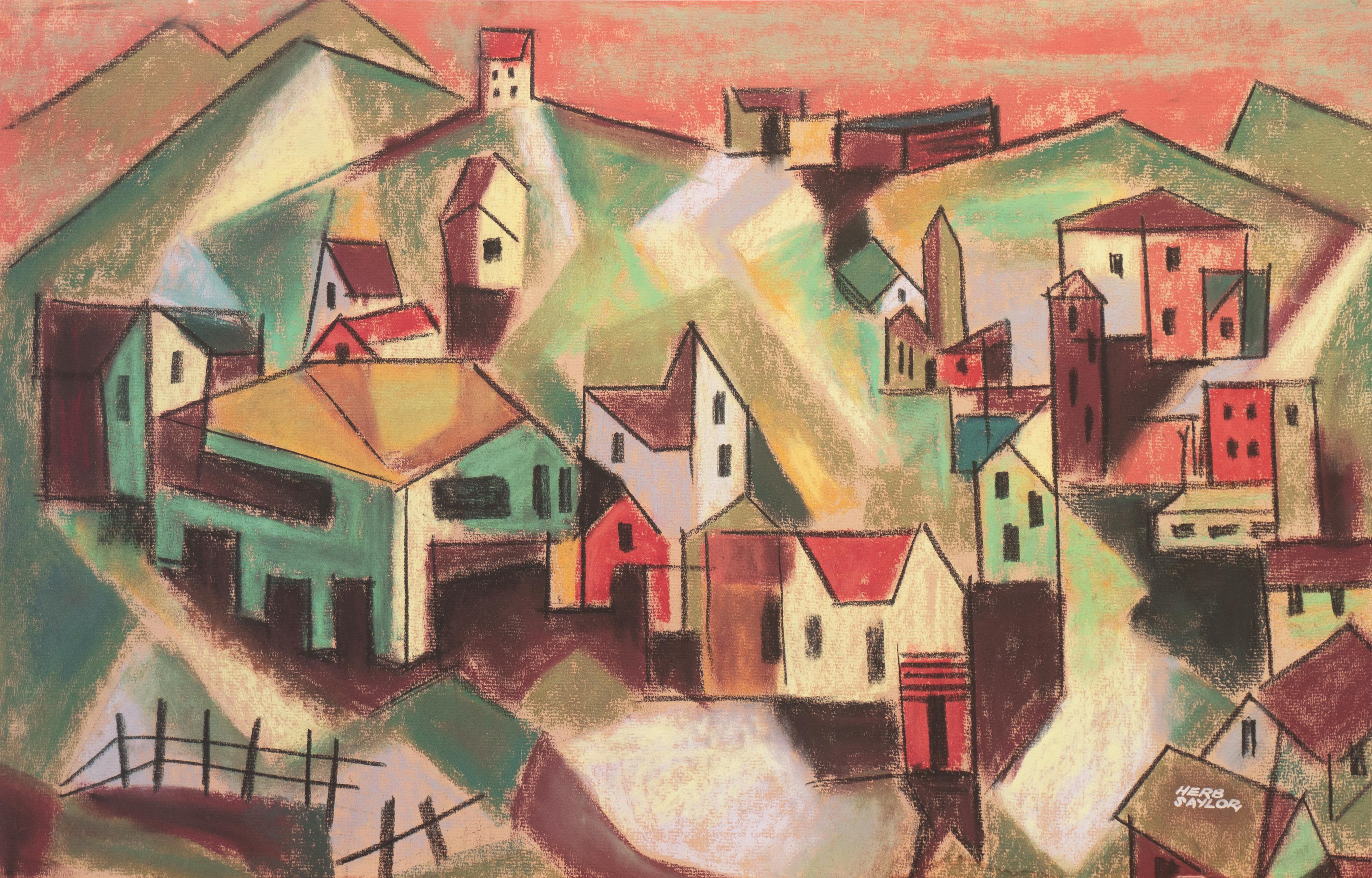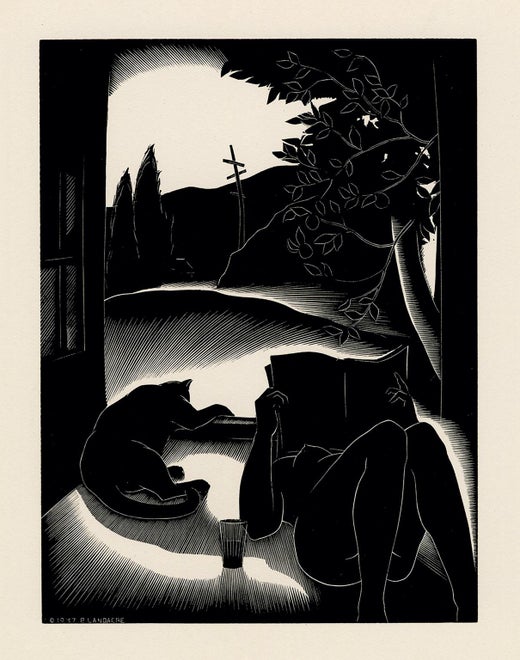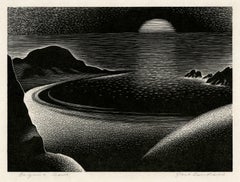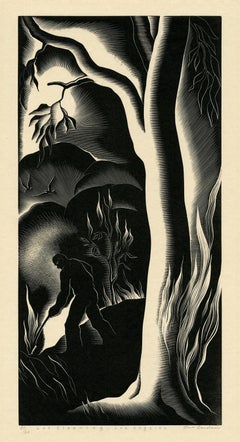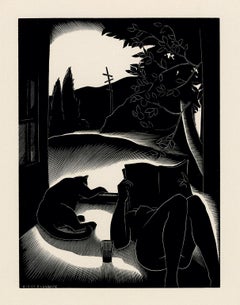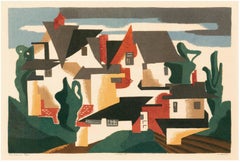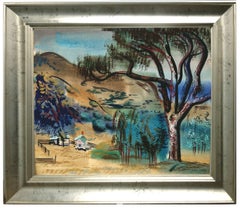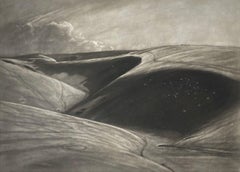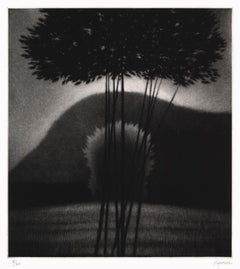Items Similar to 'Hill' — American Modernism, California
Want more images or videos?
Request additional images or videos from the seller
1 of 3
Paul Landacre'Hill' — American Modernism, California1936
1936
$5,500
£4,150.70
€4,751.92
CA$7,756.82
A$8,516.02
CHF 4,442.83
MX$103,055.76
NOK 55,683.96
SEK 52,468.93
DKK 35,471.83
About the Item
Paul Landacre, 'Hill', wood engraving, 1936, edition 60 (only 54 printed); only 2 impressions printed in a second edition of 150. Signed, titled, and numbered '49/60' in pencil. Wien 191. A brilliant, black impression, on cream wove Japan paper, the full sheet with the artist’s original brown paper hinges in the top sheet edge; margins (7/8 to 1 5/16 inches). Several spots of pale foxing in the margins, well away from the image, otherwise in excellent condition. An impression from the first edition. Printed by the artist. Archivally matted to museum standards, unframed.
Image size 5 x 8 11/16 inches (127 x 221 mm), sheet size 7 1/4 x 10 5/8 inches (184 x 270 mm).
Reproduced and exhibited: 'Paul Landacre: Prints and Drawings', Los Angeles County Museum of Art, 1983; 'Paul Landacre: A Life and a Legacy', Anthony Lehman, 1983.
Selected for exhibition at the Venice Biennale, 1938.
"In 'Hill', Landacre explores sensuality in a landscape more openly than ever before. The flowing lines of the hills in 'Point Sur' have been replaced by a soft, slightly rounded cross-hatching that describes the velvetiness of the hillside, the same technique Landacre uses to describe flesh in 'Anna' and 'Yesterday'.
'Hill' comprised part of the second series of prints presented to the Paul Landacre Association’s members and was shown in the 1938 Venice Biennale."
— 'Paul Landacre: Prints and Drawings', Los Angeles County Museum of Art, 1983.
Collections: Brooklyn Museum, Davis Museum at Wellesley College, San Diego Museum of Art.
ABOUT THE ARTIST
Paul Landacre’s renowned wood engravings are distinguished by their flawless craftsmanship and impeccable design. His elegant compositions, at once highly modernist and intimately personal, inspired both Rockwell Kent and Carl Zigrosser to name him the pre-eminent American wood engraver of the 20th century. His work garnered numerous printmaking awards—among them, his illustrated books of poems for Ward Ritchie and Alexander Dumas 'A Gil Blas in California', and his first solo book, 'California Hills and Other Wood Engravings', winner of the 'Fifty Books of the Year' (1931), American Institute of Graphic Arts. In 1946 he was elected to the National Academy of Design and in 1947 the Smithsonian celebrated Landacre at midcareer by giving him a solo exhibition which was curated by the influential painter, printmaker, and scholar Jacob Kainen.
Landacre's work is represented in the collections of the Boston Museum of Fine Arts, Brooklyn Museum, Harvard Art Museums, Library of Congress, Los Angeles County Museum of Art, Los Angeles Public Library, Museum of Modern Art, Oakland Museum of California, New York Public Library, Philadelphia Museum of Art, Seattle Art Museum, Smithsonian American Art Museum, and the Whitney Museum of American Art, among many other public collections.
- Creator:Paul Landacre (1893-1963, American)
- Creation Year:1936
- Dimensions:Height: 5 in (12.7 cm)Width: 8.69 in (22.08 cm)
- Medium:
- Movement & Style:
- Period:
- Condition:
- Gallery Location:Myrtle Beach, SC
- Reference Number:Seller: 1033761stDibs: LU53237883042
Paul Landacre
Paul Landacre was an illustrator who specialized in wood engravings of naturalistic images executed in a sparse, rhythmic, linear style. Born in Columbus, Ohio, he was an athlete as a youth. During his sophomore year at Ohio State University, he contracted a life-threatening illness that left him partially disabled. During this same year he also enrolled in a drawing class. After a long recuperation, Landacre moved with his family to California. In order to increase his physical strength he took long walks in the nearby rural areas, and on these walks, drew in his sketchbook. By 1918 he found a job as a commercial illustrator. In 1923 he enrolled at the Otis Art Institute, where he studied all types of media, including wood engraving. Landacre's artistic reputation began to emerge in the early 1930s with the publication of his book California Hills and other Wood Engravings and his first one-person exhibition in Los Angeles. He received many commissions for book illustrations; since he worked in a careful, deliberate manner, his large projects required years to complete. For thirty-one years the artist maintained a hand press in his home, allowing him to have total control over the printing of his designs. In 1939 he was made an associate of the National Academy of Design. The remainder of Landacre's professional career was balanced between teaching and illustrating books. Two examples from the National Gallery's permanent collection demonstrate the range of Landacre's work. His engraving, Smoke Tree, evokes the nearby desert scenery that the artist knew. The sharp, angular canyons of the mountain contrast with the delicate, small-leafed tree in the foreground. Some Ingredients is a still life composition that displays the same strength of line, forceful contrasts, and textures seen in his landscapes. [This is an excerpt from the interactive companion program to the videodisc American Art from the National Gallery of Art. Produced by the Department of Education Resources, this teaching resource is one of the Gallery's free-loan educational programs.]
About the Seller
5.0
Recognized Seller
These prestigious sellers are industry leaders and represent the highest echelon for item quality and design.
Platinum Seller
Premium sellers with a 4.7+ rating and 24-hour response times
Established in 1995
1stDibs seller since 2016
321 sales on 1stDibs
Typical response time: 1 hour
Associations
International Fine Print Dealers Association
- ShippingRetrieving quote...Shipping from: Myrtle Beach, SC
- Return Policy
Authenticity Guarantee
In the unlikely event there’s an issue with an item’s authenticity, contact us within 1 year for a full refund. DetailsMoney-Back Guarantee
If your item is not as described, is damaged in transit, or does not arrive, contact us within 7 days for a full refund. Details24-Hour Cancellation
You have a 24-hour grace period in which to reconsider your purchase, with no questions asked.Vetted Professional Sellers
Our world-class sellers must adhere to strict standards for service and quality, maintaining the integrity of our listings.Price-Match Guarantee
If you find that a seller listed the same item for a lower price elsewhere, we’ll match it.Trusted Global Delivery
Our best-in-class carrier network provides specialized shipping options worldwide, including custom delivery.More From This Seller
View All'Laguna Cove' — American Modernism, California
By Paul Landacre
Located in Myrtle Beach, SC
Paul Landacre, 'Laguna Cove', wood engraving, 1935; edition 60 (16 printed), 2nd edition 150 (6 printed), Woodcut Society 200, Wien 247. Signed and titled in pencil. A brilliant, black impression, on cream wove Japan, with full margins (3/4 to 1 3/4 inches), in excellent condition. Archivally matted to museum standards, unframed.
This impression is from the edition published for the Twentieth Presentation Print of the Woodcut Society, 1941. Printed by Torch Press, Cedar Rapids.
Literature: Reproduced in 'James Swann...
Category
1930s American Modern Landscape Prints
Materials
Woodcut
'Lot Cleaning, Los Angeles' — 1930s Modernism
By Paul Landacre
Located in Myrtle Beach, SC
'Lot Cleaning, Los Angeles', wood engraving, edition 60, Zeitlin & Ver Brugge 69. Signed, titled and numbered '51/60' in pencil. A brilliant, black impression, on Kitakata Japan pape...
Category
1930s American Modern Figurative Prints
Materials
Woodcut
'Sultry Day' — American Modernism
By Paul Landacre
Located in Myrtle Beach, SC
Paul Landacre 'Sultry Day', wood engraving, 1935. Edition 60, 1935; second edition of 150 (only 7 impressions printed); third edition 200, American Artists Group, 1937. Wien 170. Sig...
Category
1930s American Modern Figurative Prints
Materials
Woodcut
'The French Farm' — Mid-Century Modernism
By Edward August Landon
Located in Myrtle Beach, SC
Edward Landon, 'The French Farm', color serigraph, 1942, Ryan 86. Signed, titled, and annotated 'Edition 50' in pencil. A superb impression, with fresh colors, on cream, wove paper; ...
Category
Mid-20th Century American Modern Landscape Prints
Materials
Screen
'Partners' — Mid-Century Modernist Regionalism
By Dale Nichols
Located in Myrtle Beach, SC
Dale Nichols, 'Partners', lithograph, edition 250, 1950. Signed in pencil. A fine, richly-inked impression, on cream wove paper; the full sheet with margins (7/8 to 1 5/8 inches); tw...
Category
1950s American Modern Landscape Prints
Materials
Lithograph
'Noonday Shadows' — Mid-Century Southwest Regionalism
By Gene Kloss
Located in Myrtle Beach, SC
'Noonday Shadows', etching and drypoint, edition 75, 1941, Kloss 376. Signed, and titled in pencil. A superb, richly inked impression, in warm black ink, on buff wove paper, in excel...
Category
1950s American Modern Landscape Prints
Materials
Drypoint, Etching
You May Also Like
Landscape
By Robert Kipniss
Located in San Francisco, CA
This artwork "Landscape" c.1980 is an original color lithograph on wove paper by noted American artist Robert Kipniss, b.1931. It is hand signed and numbered 168/200 in pencil by the...
Category
Late 20th Century American Modern Landscape Prints
Materials
Lithograph
1940's California Hills Landscape
By Erle Loran
Located in Soquel, CA
Substantial and period mid-century modern American Scene watercolor of the Oakland, California countryside by Erle Loran (American, 1905-1999), 1944. Signed lower right "Earl Loran...
Category
1940s American Modern Landscape Drawings and Watercolors
Materials
Archival Paper, Watercolor
$3,250 Sale Price
35% Off
The Shadowed Valley.
By Sir Frank Short
Located in Storrs, CT
Sir Frank Short, R.A., P.R.E. 1857-1945. The Shadowed Valley. 1927. Mezzotint. Hardie 128. 14 3/8 x 19 3/8 (sheet 19 x 24). A rich, glowing impression p...
Category
1920s Modern Landscape Prints
Materials
Mezzotint
$2,750 Sale Price
38% Off
Evening II
By Robert Kipniss
Located in New York, NY
"Evening II" is a mezzotint engraving created by Robert Kipniss in 2008. Printed in an edition of 60, this impression is signed in pencil and inscribed “8/60.” The paper size is 12...
Category
21st Century and Contemporary Modern Landscape Prints
Materials
Mezzotint
'Modernist American Landscape', Merritt College, Oakland, Stanford, California
Located in Santa Cruz, CA
Signed lower right, in gouache, 'Herb Saylor' for Herbert Saylor (American, 1916-1991) and painted circa 1945.
Art educator Herbert Saylor first studied a...
Category
1940s Landscape Drawings and Watercolors
Materials
Paper, Pastel
Hillside and Stream, early 20th century modernist Cleveland School painting
Located in Beachwood, OH
Clara Deike (American, 1881-1964)
Hillside and Stream, 1916
Gouache on paper
Signed and dated lower right
22 x 18 inches
25.5 x 21.5 inches, framed
A graduate of the Cleveland Schoo...
Category
1910s American Modern Figurative Paintings
Materials
Gouache
